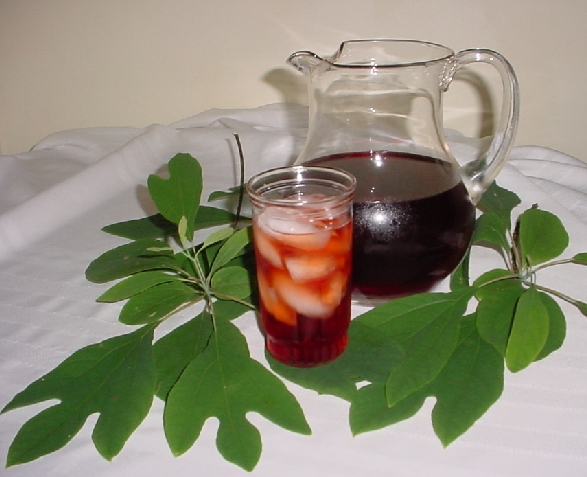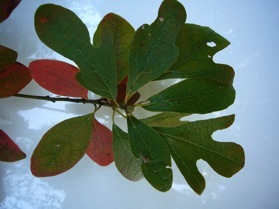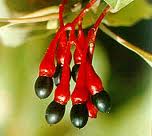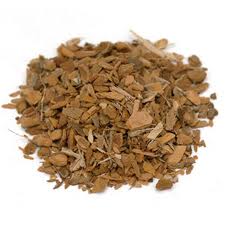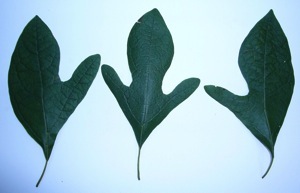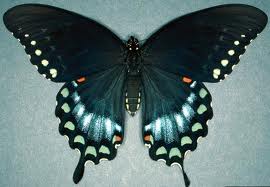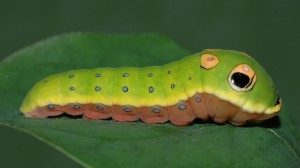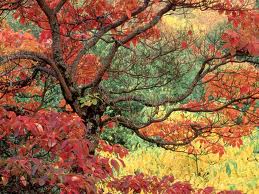Sassafras Albidum: Beaux Gumbo
Bet your sweet sassafras! If you’re on the young side ask anyone not on the young side: Root beer used to taste a lot better, a whole lot better. Why?
Because it used to be made from the Sassafras tree. Nowadays the root beer flavor is concocted from “artificial ingredients.” Why?
Because some researchers force fed some lab rats excessive amounts of sassafras oil —safrole — and they got ill. That people didn’t get ill from drinking root beer was irrelevant. Safrole was ordered off the market and the state of Louisiana nearly left the union. One can’t have file gumbo without file (fee-LAY) and file comes from the sassafras tree (Sassafras albidum.) A compromise was reached with the gumbo foes: The leaves have barely if any safrole (SAFF-roll) in them so file was allowed but nearly all other consumed uses of the sassafras tree were out.
In all fairness, safrole is a strong oil — also found in the yellow anise tree and the camphor tree. It was used to induce abortions, perhaps a muted reason why research was conduced on safrole in the first place, and why a reason was found to ban it. The lab rats who got extremely high doses ended up getting tumors in their livers and we got root beer tasting like bubble gum. But, as Dr. James Duke, below left, the author the Handbook of Edible Weeds, has written, safrole has to be put in perspective: Root beer with safrole was 1/13 as cancer-causing as alcohol in beer.
Several thousand tons of Safrole are produced yearly outside the United States in China and Brazil. Distilled Safrole is used in perfume manufacturing and in natural insecticide products. Safrole shipments, however, are highly monitored internationally because Safrole is also used in the manufacturing of the illegal drug Ecstasy. Another reason to ban it. In high doses Safrole is also hallucinogenic. Said another way, sassafras is unhealthy if you abuse it. File, fortunately, is still legal, so you can buy it or make your own, if you can find a tree.
Depending where you live the Sassafras tree —which can live to 1,000 years old — is one of the most common tree you never see, along with the Hercules Club, another topic de blog here. In Florida it’s easier to find marijuana growing in the wild than a sassafras tree… No, that’s not what “eat the weeds” is all about. But, if you do look you can find sassafras They reportedly grow as far north as Maine but I grew up in Maine and never saw one. If anyone knows where there is one in New England, please take a picture and send it along. At least one grows in Connecticut, according to a friend of mine. The usual given range is Massachusetts south to central Florida, west to Iowa and Texas. Locally — Central Florida — I know of one patch of them. One. That said when I take a month off in the summer to go hiking in the North Carolina mountains sassafras is everywhere, nearly a weed.
If you tear or crush sassafras leaves, they smell like root beer. You can make tea from the leaves by pouring boiling water over a small handful and letting them seep off heat for a few minutes, straining out the leaves. The roots of a young sapling make a better tea. It also makes a great jelly. Brew three strong cups and follow the Sure Jell recipe. Incidentally, the sassafras fruit resembles a blue berry in a red cup. It is NOT edible.
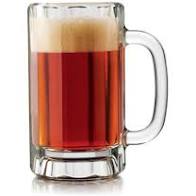
Mug of Root Beer
The name Sassafras (SASS-uh-frass) has been around for over 400 years, and there are several notions of where it came from. The leading contender is that it is a corruption of “saxifrage” which is Spanish from Dead Latin for “stone breaker” a reference to using sassafras for the treatment of kidney stones. It is diuretic. Albidum (AL-bih-dum) is also from Dead Latin and means white, referring to the tree’s white roots. Perhaps out of political correctness, many sites say Sassafras and Albidum are American Indian words but there is little evidence to support that. Incidentally “Root Beer” was originally called “root tea” by its inventor Charles Hires. A friend, however, suggested he would do better if he called it “root beer.” Hires, a pharmacist, was on his honeymoon when he came up with the formula for root beer. I’m not sure what that said about his marriage.
Sassafras has no natural enemies and its oil has been used as an antiseptic, a pain killer, and externally to treat lice and insect bites. It was once used in soaps, perfumery and toothpaste. The twigs were used as toothbrushes. Before WWI, research reportedly showed people who drank sassafras tea had fewer throat infections and colds. The wood is heavy, strong and aromatic and was used in boat and bed building. The bark can yield an orange dye.
The sassafras is nearly unique among trees by having different shaped leaves on the same tree: Right-hand “mittens,” left-hand “mittens” and double-thumb “mittens.’ On rare occasion, there will be a full glove leaf with five lobes. The leaves have no teeth. The only other “edible” tree that can claim different shaped leaves on the same tree is the Mulberry, but those leaves have teeth. In fact, my red mulberry has only oval leaves and no “mittens” at all. However Paper Mulberry trees do have very large, sand papery mitten leaves with teeth. Paper Mulberry leaves, however, are two to three times larger than sassafras leaves.
Besides having an attractive scent for human bird watchers, the sassafras’ deep blue berries are eaten by some 28 birds including bluebirds, robins, red-eyed vireos, pileated woodpeckers, bobwhites and turkeys. Bears like them too. Beavers like the bark ( and apparently are made of sterner stuff than cancer-catching lab rats.) Sassafras was one of the first exports from the new world to Europe. As early as 1584 entrepreneurs were sailing to the Americas exploring and looking for sassafras. In 1603 two ships left England for North America for the singular purpose to take home sassafras. By 1610 sassafras was so prized that providing sassafras oil was one of the conditions of the Virginia Charter. (See my Pocahontas and Gamma Rays article.) Back then, in today’s money, a ton of sassafras was worth more than $25,000. I got my sassafras tree, however, for free.
In fact, got my little sassy sassafras tree from feeding a goat. I stopped along a rail trail one day to feed a milking goat some grass that was just outside her reach — I like goats a lot — and noticed a sassafras sapling. I transplanted it to my yard because I thought it would be an unusual tree to have and I wouldn’t have to go looking for the next 1,000 years for leaves to make file. File, by the way, is not put in a gumbo, but is a thickening flavoring sprinkled on top, but I will leave those details to the Creole cooks. To make file:
Cut small branches from the tree in the fall when the leaves are starting to turn color. Wash them with water, a spray from a garden hose will do. Hang them to dry in a cool, dark place, at least out of the sun. Sun drying will fade the leaves. When dry remove leaves from the branches, and if you want, the stems from the leaves. Crush the leaves by hand. Put in a blender in small batches and blend until a powder. Sift the powder to get out any large pieces and store in a well-sealed container. A little goes a long way.
The state, national and world champion Sassafras tree — so named in 1951 — is in Owensboro, Kentucky. It is some 23 feet around and 78 feet high. Only 300 years old, it survived centuries of harvesting only to be threatened with a road widening in 1957. Then owner of the tree, Grace Rash, would have none of that. Her late husband, Dr. O.W. Rash, nominated the tree for the national register. She met the bulldozers with a shotgun and held everyone at gunpoint until a call to the governor, A.B. “Happy” Chandler, produced a pardon for the tree. The road was widened and the tree stayed, thanks to Grace, and Happy. Nowadays a governor would first take an opinion poll before acting, Grace would be locked up and on psychotropic drugs, and the tree dumped in a land fill replaced by a spindly designer picked Chinese elm sapling.
Oh, paleobotanists say the sassafras is like the ginkgo, a living fossil, going back some 100 million years…. They should’ve stuck a label on the tree: CAUTION: Eating sassafras may produce cancer in dinosaurs.
Green Deane’s “Itemized” Plant Profile
IDENTIFICATION: Leaves, 3 to 6 inches long with 1 to 3 lobes; 2-lobed resembles a mitten, 3-lobed leaf resembles a trident; green above and below and fragrant when crushed. Flower small showy, fruit, dark shiny blue ovoid in a red cup attached to a red stalks, maturing late summer. Twigs slender, green and sometimes hair, spicy-sweet aroma. Usually a shrub in the north, can be a tree in the south but usually a small scraggly tree.
TIME OF YEAR: Available year round.
ENVIRONMENT: Dry sandy spots, full sun to some shade. Here in Florida it likes to grown like a persimmon, along the edges of woods, fields and roads.
METHOD OF PREPARATION: Dried leaves for file gumbo, fresh leaves for tea, shoots and boiled roots for tea, twigs for trail toothbrush. A cup of bark in a quart of hot water seeped for 10/12 minutes can also make a good tea.
HERB BLURB
Native American Indians sassafras the local drug store. Sassafras tea served as a pain reliever, stimulant, and diuretic. Safrole used to be called, by some, Shikimic oil. Interesting. Shikimic acid is the active ingredient in the influenza preparation Tamiflu

